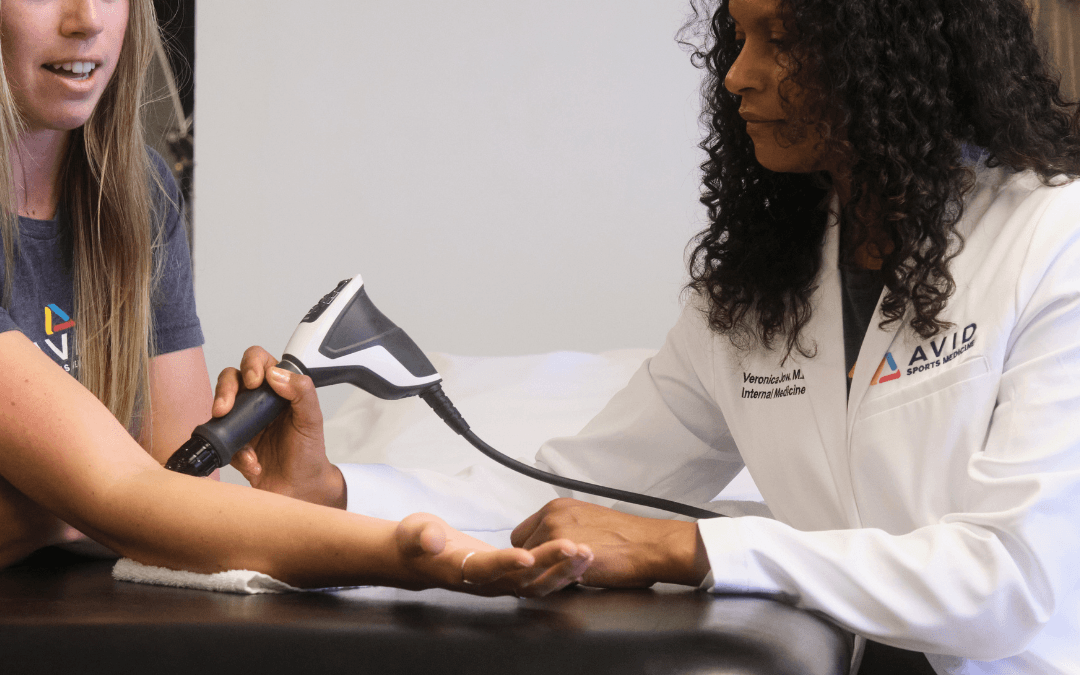Whether you’re an active individual or someone suffering from chronic pain, extracorporeal shockwave therapy (ESWT) might have come up in conversations about effective treatment options. Commonly known as shockwave therapy, this non-invasive procedure has been praised for its efficacy in treating various musculoskeletal conditions, providing pain relief, and promoting tissue healing. Contact us today for information on consultations and booking inquiries.
What is Shockwave Therapy?
Shockwave therapy, or Extracorporeal Pulse Activation Technology (EPAT), is an innovative treatment method that utilizes acoustic pressure waves to stimulate healing in musculoskeletal structures suffering from pain or injury. This procedure is non-invasive, meaning no incisions or surgical instruments are involved. Instead, it involves applying shockwaves directly to the affected area to speed up your body’s natural healing processes.
Conditions Treated by Shockwave Therapy
Shockwave therapy is used to treat a range of conditions, particularly those involving the musculoskeletal system. These include:
- Lower leg pain: Shin splints, tendinitis
- Foot, ankle, and heel pain: Achilles tendon, Plantar Fasciitis
- Neck and back pain: Trigger points
- Shoulder pain: Rotator cuff or biceps tendon
- Upper arm and elbow pain: Lateral or medial epicondylitis
- Forearm, wrist, and hand pain: Dequervain’s tenosynovitis, tendinitis
- Pelvis and hip pain: Adductor tendon, flexor tendon
- Thigh and knee pain: Hamstring muscle and tendon, IT band, bursitis, patellar tendon
- Rib pain
These are just a few examples; your medical professional may recommend shockwave therapy for other conditions not listed here.
The Benefits of Shockwave Therapy
Evidence-based: The efficacy and safety of shockwave therapy have been proven in numerous scientific studies and clinical trials. This ensures that your treatment is backed by solid research and is known to produce beneficial outcomes.
Non-invasive: Shockwave therapy is a non-invasive treatment, meaning it does not involve surgical procedures or any physical intrusion into the body. This makes the procedure safer and typically more comfortable for the patient.
No anesthesia: Since shockwave therapy is non-invasive, there’s no need for anesthesia during the treatment. This eliminates potential risks or side effects that can come with anesthesia, such as allergic reactions or post-anesthesia drowsiness and disorientation.
No risk of infection: Unlike surgeries that involve incisions, shockwave therapy poses no risk of infection because the skin isn’t broken during treatment. This is a significant benefit, as it reduces potential complications in the healing process.
No scarring: As there’s no need for incisions or stitches, shockwave therapy leaves no scars. This is particularly beneficial for those concerned about cosmetic implications.
Non-Invasive and No Downtime: As a non-invasive treatment, shockwave therapy eliminates the risks associated with surgical procedures, such as infection, scarring, and lengthy recovery times. You can resume your regular activities immediately after a session.
Preparing for Your First Shockwave Therapy Session
Before you go in for your first session, make sure to have a thorough consultation with your healthcare provider. Discuss your medical history, current health status, and treatment expectations. This discussion will help the professional tailor the therapy to your specific needs.
It’s advisable to wear comfortable clothing to the session, preferably items that allow easy access to the area being treated. Also, remember to stay hydrated; hydration aids overall healing.
The First Shockwave Therapy Session: What to Expect
Your first shockwave therapy session will begin with a consultation. Your therapist will examine your affected area, discuss your symptoms, medical history, and the goals you aim to achieve with the therapy.
The therapist will then use a shockwave therapy device on the affected area. You may feel a bit of discomfort during the process, but this is generally well-tolerated. The procedure itself is quick, typically lasting about 10 minutes.
Post-treatment, you may experience temporary soreness or swelling in the treated area. These symptoms are a normal part of the healing process and should subside within a few days. Most individuals report immediate pain relief and improved mobility after the therapy, with these benefits continuing to increase over subsequent treatments.
Experience Shockwave Therapy at Avid Sports Medicine, San Francisco
At Avid Sports Medicine, our goal is to help you overcome pain and get back to the activities you love. When you choose us for your shockwave therapy, you choose a team specializing in this innovative treatment.
As part of our unique approach, we develop a customized recovery program that integrates EPAT/Shockwave Therapy into your treatment plan. Sessions are held every 1-2 weeks for a minimum of 3-5 weeks, ensuring optimal healing and recovery.
Moreover, we’re open to combining shockwave therapy with other regenerative treatments such as Platelet Rich Plasma (PRP), offering you a comprehensive, cutting-edge solution for musculoskeletal pain.
Taking the first step towards shockwave therapy is taking a step toward pain-free living. It’s a journey to recovery, and at Avid Sports Medicine, we’re here to accompany you every step of the way. Contact us today to book your first appointment or to schedule a free consultation. It’s time to take control of your pain and reclaim your life.
ANY GENERAL ADVICE POSTED ON OUR BLOG OR WEBSITE IS FOR INFORMATIONAL PURPOSES ONLY AND IS NOT INTENDED TO REPLACE OR SUBSTITUTE FOR ANY MEDICAL OR OTHER ADVICE. OSRA MEDICAL INC AND THE AUTHORS MAKE NO REPRESENTATIONS OR WARRANTIES AND EXPRESSLY DISCLAIM ANY AND ALL LIABILITY CONCERNING ANY TREATMENT, ACTION BY, OR EFFECT ON ANY PERSON FOLLOWING THE GENERAL INFORMATION OFFERED OR PROVIDED WITHIN OR THROUGH THE BLOG OR WEBSITE. IF YOU HAVE SPECIFIC CONCERNS OR A SITUATION ARISES IN WHICH YOU REQUIRE MEDICAL ADVICE, YOU SHOULD CONSULT WITH AN APPROPRIATELY TRAINED AND QUALIFIED MEDICAL SERVICES PROVIDER DIRECTLY.

